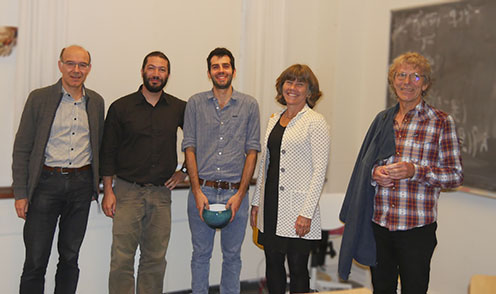Congratulations to Niccolò Maffezzoli

Niccolò Maffezzoli with supervisors and the evaluation committee. From Left: Thomas Blunier, Paul Vallelonga, Niccolò Maffezzoli, Margareta Hansson and Michel Legrand.
Congratulations to Niccolò Maffezzoli at Centre for Ice and Climate who successfully defended his PhD thesis on Thursday 12 October 2017, and obtained the degree of Doctor of Philosophy.
Niccolò will continue as a postdoc at Centre for Ice and Climate.
Title and abstract of the PhD thesis:
Title: SODIUM, IODINE AND BROMINE IN POLAR ICE CORES.
Abstract: This research focuses on sodium, bromine and iodine in polar ice cores, with the aim of reviewing and advancing their current understanding with additional measurements and records, and investigating the connections of these tracers with sea ice and their feasibility as sea ice indicators. Modern Arctic sea ice decline clearly yields further motivation in this direction, as the reconstruction of past sea ice conditions could provide clues to the mechanisms in play nowadays and in the future projections. Inductively Coupled Plasma Mass Spectroscopy (ICP-MS) has been applied for the determination of Na, Br and I in firn records retrieved at Law Dome and Talos Dome (Antarctica) and in the NEEM and Renland ice cores (Greenland).
The dissertation is presented as a monograph. It is structured in a way that would logically bring the reader from the broad perspective of sea ice and ice cores into the details of the physical and chemical transformations of these impurities from their emission to their deposition and finally to their determination in ice cores and interpretation of their climatic significance. This view reflects, to some extent, the thread of understanding that led to the research activities.
Chapter 2 briefly introduces sea ice, with particular focus on its salinity as a source of sea salt aerosols. Some features regarding the role of sea ice in the climate system and the differences between sea ice in the two hemispheres are described. The chapter ends with a brief summary of the state-of-the-art of the chemical tracers that are used in ice cores and marine sediment cores to reconstruct past sea ice.
Chapter 3 introduces ice cores with a geochemical perspective. The historically measured ions and compounds are described, together with their climatic relevance. The chapter ends with a description of the main analytic al techniques used to measure ionic and elemental species in ice cores.
Chapter 4 introduces sodium, bromine and iodine with a theoretical perspective and a particular focus on their connections with sea ice. Some of the physical and chemical properties that are believed to affect the sea salt aerosol signature in ice cores are described. Halogen chemistry is presented, with a particular focus on the halogen sources and radical chemistry in the polar boundary layer. The chapter continues with a historical review of the relevant atmospheric studies that have demonstrated the activation of halogen compounds and the importance of halogen chemistry at high latitudes. Finally, the use of sodium and bromine as sea ice tracers is introduced.
Chapter 5 describes the Renland ice core, drilled in coastal East Greenland in 2015 as part of ”Ice2Ice”, a project which aims at understanding the causes of past abrupt climate changes in Greenland. The study of the timescale and other glaciological parameters led to the calculation of the annual accumulation rate for the past 4000 years. Finally, a study of the potential sea salt aerosol sources arriving at the ice core site is presented, using back trajectory analyses of the past 17 years. The results identify the aerosol source area influencing the Renland ice cap, a result necessary for the interpretation of impurity records obtained from the ice core.
Chapter 6 reviews the published ice/snow measurements of bromine and iodine at polar latitudes. Where available they are compared to atmospheric halogen measurements. A selection of sodium records from the same locations is included to provide a more complete picture. The additional measurements performed during the research activities are also displayed. With the goal of presenting and extending the state-of-the-art of knowledge of bromine and iodine in polar snow, a critical comparison between the proxies is adopted, trying to elucidate the established and the unknown features and their potential as sea ice indicators. The last section is dedicated to the measurements of sodium and bromine in the Renland core, which could provide the first ice core-based reconstruction of Arctic sea ice in the Greenland Sea for the last 125 kyr.
Supervisor
Paul Vallelonga, Centre for Ice and Climate, Niels Bohr Institute
Assessment committee
Thomas Blunier, Centre for Ice and Climate, Niels Bohr Institute
Margareta Hansson, Institutionen för naturgeografi, Stockholms Universitet
Michel Legrand, Laboratoire de Glaciologie et Géophysique de l´Environment
